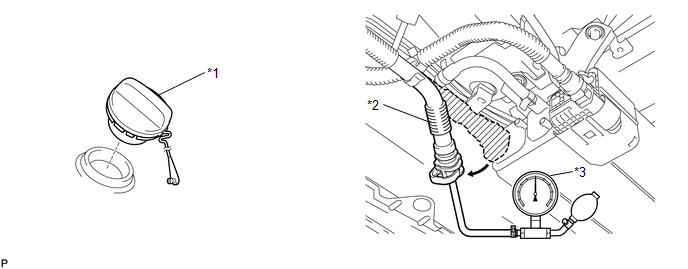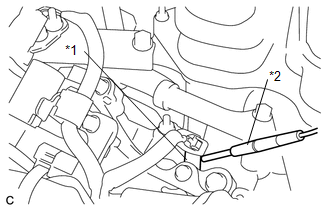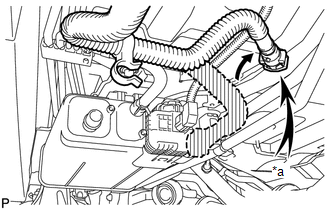| Last Modified: 08-28-2024 | 6.11:8.1.0 | Doc ID: RM100000000VIEQ |
| Model Year Start: 2016 | Model: Sienna | Prod Date Range: [12/2015 - 08/2016] |
| Title: 2GR-FE EMISSION CONTROL: EMISSION CONTROL SYSTEM: ON-VEHICLE INSPECTION; 2016 MY Sienna [12/2015 - 08/2016] | ||
ON-VEHICLE INSPECTION
PROCEDURE
1. CHECK FUEL CUT RPM
(a) Start and warm up the engine.
(b) Increase the engine speed to at least 3000 rpm.
|
(c) Use a sound scope to check for injector operating sounds. Text in Illustration
|
|
(d) When the accelerator pedal is released, check that injector operating sounds stop momentarily (at 2500 rpm) and then resume (at 1400 rpm).
Standard:
|
Item |
Specified Condition |
|---|---|
|
Fuel cut off rpm |
2500 rpm |
|
Fuel injection restart rpm |
1400 rpm |
If the result is not as specified, check the injectors, wiring and ECM.
2. VISUALLY INSPECT HOSES, CONNECTIONS AND GASKETS
|
(a) Visually check that the hoses, connections and gaskets have no cracks, leaks or damage. HINT: Detachment or other problems with the engine oil dipstick, filler cap, ventilation hose and other components may cause the engine to run improperly. If any defects are found, replace parts as necessary. |
|
3. INSPECT EVAPORATIVE EMISSION CONTROL SYSTEM
(a) Connect the Techstream to the DLC3.
|
(b) Disconnect the fuel vapor feed hose as shown in the illustration. |
|
(c) Start the engine.
(d) Turn the Techstream on.
(e) Enter the following menus: Powertrain / Engine / Active Test / Activate the VSV for Evap Control.
(f) Check that vacuum occurs at the VSV port.
(g) If vacuum does not occur, check the following items.
HINT:
- VSV (for canister purge)
- Clogging in the fuel vapor feed hose connecting the intake air surge tank and VSV
- Voltage from the ECM PRG terminal
(h) Exit Active Test mode and connect the fuel vapor feed hose.
(i) Enter the following menus: Powertrain / Engine / Data List / EVAP (Purge) VSV.
(j) Warm up the engine and drive the vehicle.
(k) Confirm that the purge VSV opens.
If the result is not as specified, replace the VSV, wire harness or ECM.
4. CHECK FUEL CUT-OFF AND FILL CHECK VALVE
(a) Disconnect the fuel tank vent hose from the canister.
(b) Connect the pressure gauge to the fuel tank vent hose.

Text in Illustration
|
*1 |
Fuel Tank Cap |
*2 |
Fuel Tank Vent Hose |
|
*3 |
Pressure Gauge |
- |
- |
(c) Apply pressure at 4 kPa (0.04 kgf/cm2, 0.6 psi) to the fuel tank vent hose.
HINT:
Perform this inspection with the fuel tank less than 90% full. When the fuel tank is full, the fuel fill check valve closes and the pressure is released through the 2 mm orifice. As a result, when the fuel tank cap is removed, the pressure does not decrease smoothly.
(d) Check that the fuel tank pressure is maintained for some time, and does not decrease immediately.
HINT:
If the pressure decreases immediately, one of the following may apply:
- The fuel tank cap is not completely tightened.
- The fuel tank cap is damaged.
- Air is leaking from the vent line.
- The fuel tank is damaged.
(e) When the fuel tank cap is removed, check that the pressure is released smoothly.
HINT:
If the pressure does not drop, replace the fuel tank assembly.
(f) Connect the fuel tank vent hose to the canister.
5. INSPECT AIR INLET LINE
|
(a) Disconnect the charcoal canister outlet tube sub-assembly. Text in Illustration
|
|
(b) Check that air flows freely into the air inlet line.
If air does not flow freely into the air inlet line, repair or replace the charcoal canister outlet tube sub-assembly.
(c) Connect the charcoal canister outlet tube sub-assembly.
|
|
|



